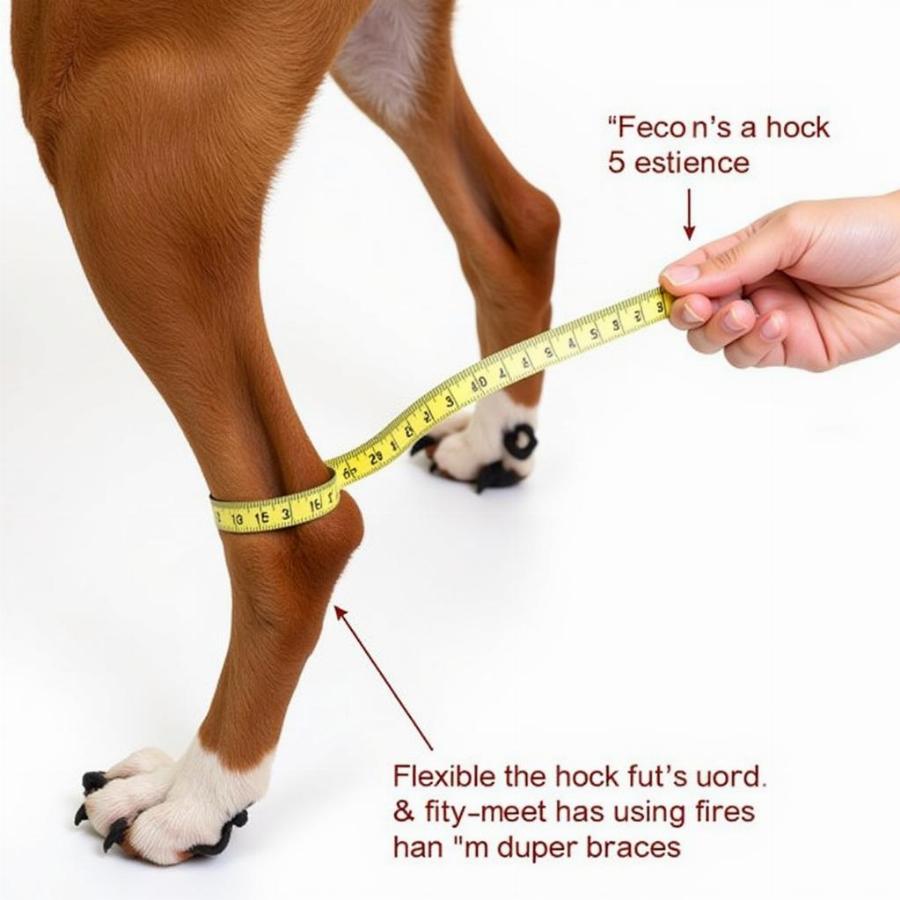A dog hock brace can be a lifesaver for dogs suffering from various leg injuries or conditions. Whether your furry friend is recovering from surgery, managing arthritis, or dealing with a sprain, a hock brace can provide support, stability, and pain relief. This guide will delve into everything you need to know about dog hock braces, from choosing the right one to ensuring its proper use and care.
Understanding the Need for a Dog Hock Brace
Why might a dog need a hock brace? Several conditions can benefit from the support a brace offers. Arthritis, a common ailment in older dogs, can cause significant pain and stiffness in the hock joint. A brace can help alleviate this discomfort and improve mobility. Similarly, sprains, strains, and other injuries to the hock can be effectively managed with a brace, promoting healing and preventing further damage. Post-surgical recovery is another area where a hock brace excels. By stabilizing the joint, it reduces stress on the surgical site and allows for proper healing. Even neurological conditions that affect a dog’s ability to control their legs can benefit from the stability provided by a hock brace.
Choosing the Right Hock Brace for Your Dog
Selecting the right hock brace is crucial for its effectiveness. Factors to consider include the size and breed of your dog, the specific condition being addressed, and the level of support required. For smaller dogs, a small dog knee brace might offer similar support if the hock brace is unavailable in their size. Measure your dog’s hock circumference carefully to ensure a proper fit. The brace should be snug but not too tight, allowing for comfortable movement without restricting blood flow. Consider the material of the brace. Neoprene offers good support and warmth, while breathable fabrics are ideal for dogs with sensitive skin.
What if my dog needs support for other areas?
If your dog requires support beyond the hock, options like a dog compression sleeve or braces for dogs back legs are available to address specific needs. A dog foot brace may be necessary for paw injuries.
 Measuring a Dog's Hock for a Brace
Measuring a Dog's Hock for a Brace
Using and Caring for a Dog Hock Brace
Once you’ve selected the right brace, proper usage is key. Follow your veterinarian’s instructions carefully regarding how long and how often your dog should wear the brace. Introduce the brace gradually, starting with short periods of wear and gradually increasing the duration. Monitor your dog for any signs of discomfort or rubbing. Keep the brace clean by regularly washing it according to the manufacturer’s instructions.
How do I clean my dog’s hock brace?
Most braces can be hand-washed with mild soap and water. Ensure the brace is completely dry before putting it back on your dog. Regular cleaning prevents the buildup of dirt and bacteria, promoting hygiene and prolonging the life of the brace.
When to Consult a Veterinarian
While a dog hock brace can be highly beneficial, it’s essential to consult with your veterinarian before using one. They can diagnose the underlying cause of your dog’s discomfort, recommend the appropriate type of brace, and provide guidance on its proper use. If your dog experiences any worsening symptoms or develops new issues while wearing the brace, contact your veterinarian immediately.
Conclusion
A dog hock brace can significantly improve the quality of life for dogs struggling with hock-related issues. By providing support, stability, and pain relief, these braces can help dogs regain mobility and enjoy a more active lifestyle. Remember to choose the right brace, use it correctly, and consult your veterinarian for guidance throughout the process.
FAQs
- How long can a dog wear a hock brace? This depends on your dog’s individual needs and the specific condition. Follow your veterinarian’s recommendations.
- Can a hock brace be used for both hind legs? Yes, some braces are designed for use on either leg.
- Are there different sizes of hock braces? Yes, braces are available in various sizes to fit dogs of different breeds and sizes.
- What are dog hock braces made of? Common materials include neoprene, nylon, and other breathable fabrics.
- Can my dog sleep with a hock brace on? This depends on the specific condition and your veterinarian’s advice.
- How do I know if the hock brace fits correctly? The brace should be snug but not restrictive, allowing for comfortable movement without cutting off circulation.
- How often should I clean my dog’s hock brace? Regular cleaning, as per the manufacturer’s instructions, is recommended.
Further Reading
If you’d like to learn more about other supportive options for your dog, you may find these articles helpful: dog carpal brace.
Beaut Dogs is your trusted resource for all things related to dog care, offering expert advice and valuable insights into the world of canine companions. For personalized assistance and answers to your specific questions, contact us at Email: [email protected]. We’re here to help you provide the best possible care for your beloved furry friend. Visit us at Beaut Dogs today!